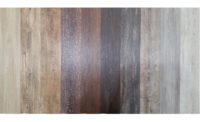2024 Rigid Core Flooring Category Report

Photo: Getty Images.
Innovation abounds for the rigid core category in 2024, spurred by consumer demands for more sustainability and style, supply chain considerations, and technological innovation.
“We're seeing an evolution in this product category,” said Brian Wood, VP of resilient for CCA Global Partners, who spoke at the cooperative’s winter convention in Dallas, Texas, in January. “It's been a challenging year to say the least.”
The Uyghur Forced Labor Prevention Act (UFLPA) continued to challenge many suppliers since enforcement began just over a year ago. UFLPA is a United States federal law that changed U.S. policy on China's Xinjiang Uyghur Autonomous Region with the goal of ensuring that American entities are not funding forced labor among ethnic minorities in the region.
Supply of resilient hardwood flooring was affected, and the industry pivoted by moving to other countries for manufacturing, such as Vietnam. Most significantly, however, there has been a surge in domestic production with several new flooring manufacturing plants opening in the United States and Mexico.
Engineered Floors invested in a digital LVT (DLVT) plant in Dalton, Georgia. According to the company, the 400,000-square-foot facility can produce 200,000 square feet of LVT flooring, marketed under the brand, PureGrain, per day, up to 72 million square feet annually.
“We have to create confidence behind the product,” said Joe Young, VP of product development at Engineered Floors. “It always amazes me that people can be so confident in buying a product from halfway around the world, and when there is finally an option to go domestic, there are lots of question marks. We have the best manufacturing group in the industry, and they have worked tirelessly to preserve our reputation built on quality and service. It’s up to the rest of us to continue to innovate and market DLVT and its advantages.”
Another domestically made launch that caught retailer attention is Mohawk’s PureTech, which features a renewable poly core (RPC) that is made from a renewable fiber-based product. It's PVC-free, lightweight, and made in the United States. “PureTech was launched last summer and it was a huge hit,” Wood said.
PureTech is just one example of PVC-free flooring that has launched over the last year as the U.S. Environmental Protection Agency (EPA) announced that vinyl chloride, a component of LVT flooring, will be one of the next five chemicals selected for prioritization under the Toxic Substances Control Act.
“We've seen a number of market signals and indicators that have pointed to the opportunity for more PVC-free flooring options in the market.”
– Kelly Fain, EVP, Shaw commercial division
Vinyl flooring has been the fastest growing material for a number of years, and the EPA's attention and actions will accelerate bringing PVC-free alternatives to the consumer.
“We believe this risk evaluation will further assure that the production of vinyl chloride and use of PVC products are safe,” said Ned Monroe, president and CEO of the Vinyl Institute. “Manufacturers of vinyl chloride adhere to some of the most stringent safety and environmental regulations in the chemical industry.”
In October 2023, Shaw Industries announced a partnership with the Classen Group, a hard surface flooring manufacturer based in Germany that offers PVC-free solutions for commercial and residential environments. Through this partnership, Shaw will become the sole distributor of the company’s new commercial flooring products in North America.
“We've seen a number of market signals and indicators that have pointed to the opportunity for more PVC-free flooring options in the market,” said Kelly Fain, EVP of Shaw's commercial division. “We saw large architect design firms that in the past 18 months have removed PVC product from their product libraries. They're a growing group that would like to see more PVC-free solutions.”
If the EPA does determine that environmental protections are needed, it means that manufacturers will need to innovate and overcome the challenges of developing sustainable products that can replace the price, design flexibility, and performance of PVC.
“End users have gotten used to the price and design flexibility of PVC/vinyl flooring,” said Tim Cole, director of sustainability and technical services at Windmoeller. “One of the main reasons why PVC flooring was developed and received immediate market acceptance and continued growth. The market says that it is committed to sustainability, but users are not willing to spend more than maybe 10 to 15% more for the ‘environmentally friendly’ product. And most green chemistry/materials cost more.”
See more features from our February 2024 issue!
Looking for a reprint of this article?
From high-res PDFs to custom plaques, order your copy today!






